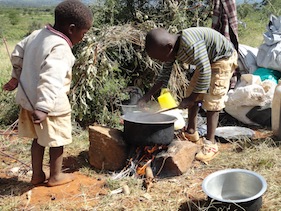
Close to 2,000 children are under some form of detention in Australia
“You cannot underestimate the human cost of detaining children,” Jeroen Van Hove, the coordinator of the (IDC), an umbrella group of 258 members (including organizations) working in 50 countries around the world, based in Belgium, told IRIN, describing Australia’s detention regimes as one of the “harshest” in the world.MELBOURNE, 5 March 2013 (IRIN) – Australia is failing in its international obligations to protect the rights of close to 2,000 children now in immigration detention, say rights groups and legal experts.
“You cannot underestimate the human cost of detaining children,” Jeroen Van Hove, the coordinator of the (IDC), an umbrella group of 258 members (including organizations) working in 50 countries around the world, based in Belgium, told IRIN, describing Australia’s detention regimes as one of the “harshest” in the world.MELBOURNE, 5 March 2013 (IRIN) – Australia is failing in its international obligations to protect the rights of close to 2,000 children now in immigration detention, say rights groups and legal experts.
“You cannot underestimate the human cost of detaining children,” Jeroen Van Hove, the coordinator of the International Detention Coalition (IDC), an umbrella group of 258 members (including organizations) working in 50 countries around the world, based in Belgium, told IRIN, describing Australia’s detention regimes as one of the “harshest” in the world.
“The current detention policy causes serious damage to these children and has been criticized internationally for its human rights violations.”
According to Australia’s Department of Immigration and Citizenship, as of 1 March there were 1,983 children (under 18) in immigration detention, including 998 in secure locked facilities and 985 detained in the community (the preferred option for children as it allows them to live in community-based accommodation without the need to be escorted outside a locked facility).
Of these, 281 are detained on Christmas Island (off the coast of Indonesia), while a further 34 are on remote Manus Island in Papua New Guinea (PNG) as part of the government’s controversial offshore processing efforts.
Activists there describe conditions as “overwhelmingly inadequate”.
This is a “blatant violation of international norms and arguably in breach of a range of UN Conventions,” Linda Briskman, a professor of human rights at Swinburne University, charged. “There is a mounting body of evidence, particularly from mental health professionals and researchers that reveals the terrible harms resulting from the detention of children.”
Mental health impact
Asylum advocacy groups in Australia have long raised concerns following reports of self-harm and trauma experienced by children in low-security facilities.
In February, an Australian-based organization, the Darwin Asylum Seeker Support and Advocacy Network (DASSAN), received reports from the Immigration Department under Australia’s Freedom of Information Act detailing self-harm among children at two Darwin detention centres.

Outside a Darwin detention centre
“These reports explain there were 26 self-harm incidents in Darwin centres from August 2010 to November 2011. The youngest child was only nine years old and he took an overdose of Panadeine, knowing what the full effects on him would be,” DASSAN coordinator Fernanda Dahlstrom said.
This was despite the fact that the Darwin airport lodge is considered more humane than other processing centres, she added.
“These cases aren’t isolated. More children are suffering the same psychological side effects as a result of detention in other facilities. We just don’t officially know the numbers,” said Leila Druery, a spokeswoman for ChilOut, an advocacy group for children in immigration detention in Australia.
“We would like to see the issue of detaining children depoliticized, by giving an independent children’s commission an oversight and guardianship role,” Druery explained, in reference to the current conflict of interest where the immigration minister is the sole person who decides if his own department is acting in the best interests of the child.
The Australian Red Cross echoes these concerns on placing children in detention centres for unknown periods of time while their refugee status is processed.
“[The] Australian Red Cross believe community-based detention for asylum seekers is a humane and sustainable alternative to the use of secured detention facilities and arrangements,” the Red Cross said in a statement.
“Evidence shows that when people spend long periods in immigration detention facilities, not only does their health suffer, but also their ability to cope and their psychological well-being.”
Rights of the child
Legal experts in Australia point to the responsibilities the government has under its international obligations, including as a signatory to the UN Convention on the Rights of the Child (CRC).
“Perhaps, the most obvious treaty breach is that of CRC. Clearly, maintaining children in detention for long periods of time does not treat their welfare as the paramount consideration,” said Stephen Keim, a Brisbane barrister and the president of Australian Lawyers for Human Rights.
Keim noted that when the periods of detention were long and indefinite so as to affect the mental health of the children involved, or the conditions are unsatisfactory, “issues of cruel, inhumane and degrading treatment arise,” which is prohibited under the Convention Against Torture, the CRC and the International Convention on Civil and Political Rights.
According to CRC, the detention of children should be used “only as a measure of last resort, for the shortest appropriate period of time and taking into account the best interests of the child.”
In February, a report by the UN Committee on the Rights of the Child asked states to “expeditiously and completely cease the detention of children on the basis of their immigration status”.
The UN Refugee Agency (UNHCR) has also expressed deep concern over the treatment of children in the Manus processing centre, which was reopened on 21 November 2012 in PNG.
“The mandatory detention of 34 children and their families at the Centre is particularly troubling for us,” said UNHCR regional representative Richard Towle.
The UNHCR report released on 4 February 2013 following a visit to the Manus Island facility noted that: “When viewed against the applicable international legal standards, it is clear that the current situation for detained children is profoundly unsatisfactory and UNHCR is therefore of the view that it is not currently appropriate for children to be transferred to Manus Island.”

Immigration remains a divisive issue in Australia
Duty of care
Refugee policy has long been a divisive issue in Australia, even though the country receives a small number of refugees annually compared to other countries including the USA, France, Germany, Italy, and Sweden.
In 2011, Australia received 15,441 onshore asylum applications, just 0.92 percent of the 1,669,725 applications received across the world, the Refugee Council of Australia reported.
However, according to Australia’s current labour government, the government is committed to ensuring people held in immigration detention are treated with dignity and respect and that children are always accommodated in the least restrictive form of detention accommodation available.
“No-one wants to see children in detention for long periods, which is why children have priority processing and the department endeavours to process their claims quickly,” said Brendan O’Conner, Australia’s minister for immigration and citizenship, in a statement provided to IRIN.
“The Australian government has a duty of care to ensure the health and wellbeing of children in immigration detention – including ensuring access to appropriate physical and recreational activities and excursions and education,” added O’Conner.
At the same time, all irregular maritime arrivals have to be detained while their “identities, health and reasons for travel are ascertained”.
Meanwhile, the Greens, a minority party that currently holds the balance of power in the Australian Senate, are campaigning for policy change when it comes to placing children in detention.
“Some of these children have spent their whole lives behind bars, having committed no crime other than being born in a country from which they are forced to flee,” said Senator Hanson-Young, who visited the detention centre in Manus Island in February.
“The government needs to end this cruel regime of indefinite detention.”
Since January 2013, most of the 1,382 irregular maritime arrivals were asylum seekers arriving by boat from Iran, Afghanistan, Bangladesh and Pakistan.



 Initial estimates from December suggest the number Syrian refugees could be more than a million by June. (Mohammad Hannon/Associated Press)
Initial estimates from December suggest the number Syrian refugees could be more than a million by June. (Mohammad Hannon/Associated Press)





